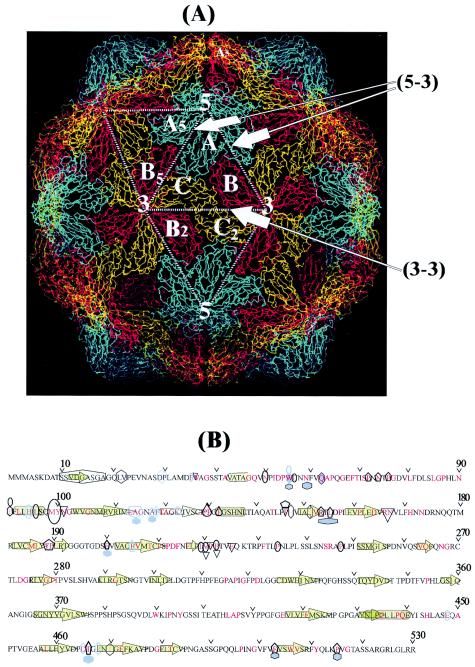FIG.3.
(A) Interactions of the S domains of the NV subunits across the different icosahedral symmetry axes. The locations of these axes are shown by the corresponding numbers. Subunits A, B, and C are related by a quasi-threefold (shown by a triangle) and C and C2 are related by an icosahedral twofold axis. Subunits A and B5 are related by quasi-twofold axes, and C is related to B5 and B2 by quasi-sixfold symmetry. Subunits A and A5 are related by a strict fivefold axis. The broken lines joining the icosahedral symmetry axes are the icosahedral interfaces indicated by arrows. The line (5-3) joining the fivefold and the threefold axes includes the A-B5 (dimeric), A-A5 (pentameric), and the C-B5 (hexameric) interface regions while the line (3-3) joining the two threefold axes, includes the C-B2 (hexameric) interface region. Similarly, the quasi-trimeric A-B, A-C, and the B-C interface regions lie on the boundaries between the A, B, and the C subunits. (B) NV conserved residues with reference to the secondary structure and icosahedral interfaces. Filled green arrow, β-strand; filled green cylinder, helix. The ACRs are shown in red along with their locations with respect to the icosahedral symmetry axes that are shown, using different symbols: oval, twofold axis; inverted triangle, threefold axis; hexagon, quasi-sixfold axis; pentagon, fivefold axis; and teardrop, quasi-threefold axis. A black border around the symmetry axes symbols indicates a buried residue, while no border around the symbol indicates an exposed residue. Multiple symbols on ACRs indicate the presence of multiple symmetry axes about which these residue(s) interact with other subunits.

